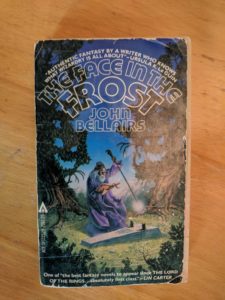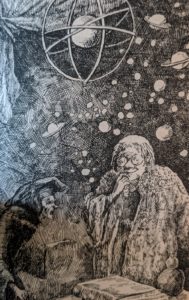
The Greatest Story Ever Told: The Face in the Frost
In this first installment of TGSET, we’re looking at The Face in the Frost by John Bellairs. Normally in TGSET articles, I won’t be claiming the covered story is literally the greatest story ever told, but just a great works of storytelling. Except in this case.

The Face in the Frost[1] is my favorite book and has been my entire life. I remember my mother reading the entire novel aloud to us on rainy afternoons when we couldn’t go outside. Since then, it has held a special place in my heart. Thus my thoughts on the book will be very biased by personal feelings and nostalgia. But I will argue (to literally anyone who will listen) that this underappreciated book is a master work of fantasy fiction and of storytelling in general. It’s unique tone, characters and depictions make it a work that I believe everyone should read. Now.
As with all TGSET articles, there will be spoilers ahead. Normally, I wouldn’t say that it is strictly necessary to experience a story before reading the article but, dang it, this book is so good that you shouldn’t let anything get in the way of reading it, even this article. Seriously, go read this book right now. The book was out of print for a bit[I remember checking used book stores for years as a teenager to replace my overworked copy], but then it was reprinted, and is now available as an ebook through Open Road Media. And no, I’m not sponsored by them; I just love this book.
So go read the book now and come back when you’re done.
Background
First published in 1969, The Face in the Frost is a wonderful fantasy book filled with whimsy and terror. It is one of John Bellairs's earlier published works. Bellairs mostly wrote children's and young adult books so The Face in the Frost was his last major attempt at writing for an adult (or better, ‘general’) audience. While I cannot find exact numbers, my understanding is that the book had modestly admirable sales, though was not largely successful. It received critical praise and some notable voices have recommended the book over the years, including Gary Gygax[2] (Dungeons & Dragons) and Ursula K. Le Guin [3].
As stated, the book is a fantasy story focusing on the wonderfully named Prospero and Roger Bacon (“and not the one[s] you are thinking of, either”), two old wizards in their twilight years. The lives of these two grumpy yet whimsical men is slowly, insidiously invaded by an indescribable terror. Prospero seems to be particularly hounded by disturbing entities and the two friends set out to find the root of the darkness coming over the land.
Tour de Force
John Bellair was a fairly prolific and successful fantasy author and knew how to create an engaging, gripping story. In describing why this book is so good, I’ll touch on many special aspects of his style and writing. But through it all, his techniques are supported by great story structure. No part of his particular style would work without it.
At every point, the characters are driven forward with short and long term goals. The reader feels the growing, palpable sense of fear and tension throughout the book. Each plot point leads seamlessly to the next and the journey the character’s take feels natural to both their motivations and to the world, without coming off as overly plotted or fortuitous.
With that said, let’s move on to what really makes The Face in the Frost shine…
Wonderful Characters
The most prominent features of the book are Prospero and Roger, their characteristics and their relationship. These are not young people on the verge of adulthood, chosen ones, grim adventurers nor a rag-tag team of misfits. It’s two old men who are okay at magic. Not great.
Theirs is not a budding friendship that we see develop over the course of the book. These two have known each other for decades. Their relationship is well tested and has a depth that would not be possible for new friends. When Roger and Prospero lose each other, both told that the other has been killed, their grief is real and heavy with the years they have spent together. Their reunion is similarly complex and moving.
Bellairs is able to convey to the audience early on how close they are, not through overt exposition but most powerfully through the nuances of their interactions at the start of the book. All the characters in the book are introduced with finesse and depth without long descriptive passages or adding chapters of character development that would slow down the pace of this short, sweet novel.
Whimsy and Terror
Prospero suddenly knew what was going on. “Oh, good heavens! Great elephantine, cloudy, adamant heavens full of thunder stones! Roger! You can’t be serious. Are you?” Roger was looking around and drumming his forefinger against his teeth. “If I were serious, I would never have become a wizard, would I?”
The Face in the Frost is set in a world of magical whimsy. The wizards in this world rarely perform world-rending spells, throw lightning bolts or take over the minds of their enemies. Instead, they follow their silly interests, create absurd houses and are generally useless. The world around them mirrors this lightness, at first.

Bellairs's genius is exemplified by the believability of this whimsy and its juxtaposition with the terror that develops throughout the plot. A great example of this dichotomy is in the character of Gorm. King Gorm rules over a small, meaningless kingdom and spends his time and magical abilities creating a model universe full of silly galaxies and careening comets. His silliness surpasses even that of Prospero and the principle characters’ visit to his castle is the audience’s last view of normalcy in this world.

But as terror creeps over the land, the audience hears what will become of that normalcy:
Prospero knew the temperament of certain southern rulers, who would—after the victorious northern kings had gone home—hold their own witch trials and take out their anger on “disloyal”—that is, weak—kings like silly old Gorm.
The initial whimsy of Bellairs's world invites the audience into it, reminding us of the likes of Lewis Carroll[4] or Edith Nesbit[5]. It is comforting and relatable for any fantasy fan. Thus, the gradual corrupting of this world, more psychological and realistic than corruption in most fantasy novels, drives the tension and stakes of the story and causes an almost visceral reaction on the part of the audience. It co-opts that comfort and all the expectations that comfort is based on such that it is not merely the world that is falling prey to terror but the audience’s own emotional state is as well.
Epic No More
Similar to the banality of magic described above, the story and world of The Face in the Frost are decidedly unassuming. The two main characters are not world class magicians, nor even worthy of a county fair. The locations depicted are not grand empires, the sites of ancient civilizations or the center of an age-old conflict. Nothing about the situation described recalls the mythos and wish fulfillment commonly associated with fantasy tales.
From a plot perspective, Prospero essentially saves the world. Or at least, his world. The north and south kingdoms are both in danger from a force they cannot resist and there is no indication that this force cannot extend limitlessly beyond these kingdoms. But at no point is Prospero marked as the chosen one, the savior or the champion. No one in the world seems to know Prospero outside of his normal circle of friends nor are his accomplishments recognized afterwards. He is not remarkable in reputation, skill, situation, or in any other aspect. Put simply, Prospero isn’t special.
Yet, he is the one who must rise to the occasion, who is given the key to the puzzle, who has the sole connection with the antagonist that makes victory possible, who struggles against great odds and great danger to face the coming evil. The Face in the Frost is essentially an epic[6] story that makes every effort to hide its epicness.
With this strange dichotomy, we have a moving, deep story whose stakes are engaging and terrifying. The story is also approachable, comfortable and fun. There is no silly feeling that the story is unrealistic to the point of ridiculousness or that it is taking itself too seriously. Every character is relatable in a very real sense.
The stakes are actually raised even higher because we are very aware that Prospero and Roger are not particularly remarkable or possess special powers. The story is filled with a very real sense of helplessness. Though the main characters are wizards, magic is repeatedly described as being a generally mundane, almost silly practice and their magic seems to be mere child’s toys compared to that of Melichus, the antagonist. They have no special weapon to fall back on.

The description of evil compounds the sense of helplessness vis à vis non-epicness. Evil has no vast army, no easily describable super power, no obvious goal of domination. None of the archetypes of evil that make it scary or that heighten a story’s stakes are present. Instead, evil fills the world in insidious ways that can neither be confronted nor even rightly described.
In the roadside towns, the wizards picked up stories and rumors. One man told how frost formed on the windows at night, though it was only the middle of September. There were no scrolls or intricate fern leaves, no branching overlaid star clusters; instead, people saw seasick wavy lines, disturbing maps that melted into each other and always seemed on the verge of some recognizable but fearful shape. [...] In some towns, people talked of clouds that formed long opening mouths. [...] Doors opened at night inside some houses, and still shadows that could not be cast by firelight fell across beds and floors. People who lived near forests and groves dreamed that the trees were calling to their children; in the daytime, pools of shadow that floated trembling around the trees seemed darker than they should have been, and when the children showed an unusually strong desire to play in the woods, panicked parents locked them indoors. Voices rose from empty wells, and men locked their doors at dusk.
Bellairs's power of description, which we will touch on more, provides a masterful sense of the evil threatening the world. This evil, from most people’s standpoint, has no discernible source. In most of the descriptions, exactly why something is so frightening is not easily explained. The evil coming over the North and South Kingdoms manifests itself deep in our psychologies, for both the characters and the audience. It comes alive in the small but disturbing alterations from the norm, from things that should not be significant but are terrifyingly out of place and just not right.
‘Disturbing details’ is a great way to describe the evil of The Face in the Frost and it is in the details that Bellairs avoids the epic to make an evil that is all the more insidious and unsettling. And again, the lack of in your face epicness is what makes Prospero and the audience feel so helpless. One cannot fight a shadow, particularly if it is not cast by any light source. The intangible and small provides us no means to fight back or even escape. It is a masterful means to describe a terror which shatters a world of whimsy and normalcy.
The Art of Not Describing
As touched on above, one of Bellairs’s great talents is his power of description. In a single line, he can describe the atmosphere of a location, including its characters and history. When Prospero reaches one particular inn, Bellairs writes:
A brass cylinder marked “Salt” held thick peeling cigars—the innkeeper rolled them himself—and Prospero lit one from the candle.
The mismatch of a salt container being used for cigars with the note about the innkeeper making the cigars himself provides a deep sense of the establishment without describing the appearance of the building or going into detail about its history and clientele.
That line is a great example of why Bellairs’s descriptions are so powerful. Essentially, he leaves the description very undescribed. That creates breathing room for the audience’s imagination to fill in details. He sets the direction in such a way that the mind can’t help but do the rest of the work.
This technique is especially effective, as we’ve touched on, in creating a sense of evil and terror.
Everything lay under a dull gray light; the bulging clouds overhead looked as though they were going to burst. But every object in the yard threw a shadow, a small dark trembling patch. One of them, cast by nothing that Prospero could see, lay on the grass near him. It started to crawl toward him slowly.
The shadow is left completely undescribed except for the words ‘trembling’ and ‘crawled’. Yet it instills a feeling of horror on the part of the audience. The few descriptive words chosen provide a clear direction for the imagination to run in but allow the flexibility for that imagination cater to the individual’s fears.
Reception
The Face in the Frost never achieved the success of Tolkien or Le Guin or even of Bellairs’s later books. But it was very well-received critically. Author and critic Lin Carter[7] called it “[one of] the best fantasy novels to appear since The Lord of the Rings” and author Ursula K. Le Guin described the book as “authentic fantasy by a writer who knows what wizardry is all about”
Perhaps the lack of large scale popularity can be attributed to the type of story it tells. It is not a coming of age or chosen one story. The main characters are two old, grumpy, silly men. There is very little wish fulfillment. The characters do not align with our common conception of heroes. In a word, the book is not market-friendly.
If the novel suffers from any storytelling flaws, it is that the resolution resides at the edge of deus ex machina[8] territory. The solution to the conflict is well seeded[9] but how it works exactly still comes a bit out of left field. I enjoy that this solution is left largely unexplained, for the characters and for the audience. It adds to the complexity of the story and the inexplicable nature of the antagonistic force. But such a conclusion can leave some readers with a bad taste.
In the End
Hopefully, I’ve impressed on you how much I love this book and even convincingly reasoned why I think it is so good. Bellairs was a master of storytelling and a master of writing. His powers of description, the well structured rise in tension, the clash of the comforting and the terrifying, all these elements create a novel which is a delight for any reader.
But most importantly, I can offer my experience. The Face in the Frost is a comfort book for me, thanks to its story and my memories. Each time I read it, I start out full of warmth and fun, like greeting an old friend. And before I know it, I inevitably find myself huddled in a dark room, filled with terror and dread. Then I’m out the other side, back to a world of gentle whimsy, one which I now value more deeply by seeing the possible hell it almost became. Every time it is a rewarding experience. I have never become bored of this book. The Face in the Frost has never failed to bring my heart a joy and excitement against which I measure all other books.
I hope this is enough to convince you to read it. I love this book dearly and I hope you will to.
Footnotes:
- [1] Wikipedia
- [2] Wikipedia
- [3] Celebrated science fiction and fantasy author, known for such books as The Left Hand of Darkness
- [4] 19th century English writer of literary nonsense, though his famous works could be categorized as fantasy, like Alice's Adventures in Wonderland
- [5] Turn-of-the-century English writer known for such works as The Book of Dragons
- [6] ie. grandiose or similar to many high fantasy plots
- [7] Wikipedia
- [8] Where the resolution is suddenly accomplished by an unintroduced force at the end of the story
- [9] References made to it earlier in the book